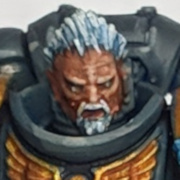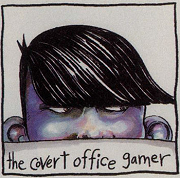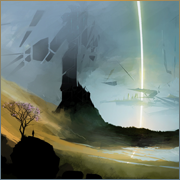|
lilljonas posted:Could you link it to experience of the troops? Crappy grunts need to be closer to the sergeant or equivalent, while super duper space paratroopers can spread out more, and function more independently? This is a good idea. I've been thinking loosly about somehting like that as an ability, but actually making it a stat to differentiate troops would be very nice. Space Marines can operate basically as IC's, while IG conscripts need to be able to hold hands. I can see some issues with large coherencies and a system where shooting is resolved pr. squad, but I think they can be solved.
|
|
|
|

|
| # ? Apr 25, 2024 16:32 |
|
I'm not sure why we're focusing on dice rather than considering combat results tables, which all by themselves have the big advantage that you can predict how your actions will turn out and can focus on anticipating your opponent's actions rather than establishing backup plans for luck failing you. Combining them with dice, you can get everything down to a single roll. Not to mention that you have much more direct control over what forces are viable, so that you can establish lists or points or however you build armies to create balanced forces. So, for example, if you want a game where elite units are critical to success, having the grunt v grunt and elite versus elite tables set up so that 85% of the time the forces take nearly equal casualties but elites can cut through grunts with ease will in turn create the situation you wanted more easily than just giving the elites the big numbers and the grunts the little ones. Or if you want to have a Fire Emblem thing where spears counter swords which counter axes which counter spears. Then instead of having lots of special rules based around how much damage you can do or hits you can absorb, you can simply bake that right into tables that will be regularly looked up anyways, freeing up people's memory for other, more interesting special rules.
|
|
|
|
So random vs nonrandom activations. I dig random activations. There's something appealing to me about dealing with the element of unreliability; I feel it adds a distinct command-aspect to the game that many games ignore. Now, that said, I very much dislike when troops just sit in place all game because activations didn't work out for them. The obvious answer is just to have order of activation random; you still move everything, just who goes first changes. But I do wonder if there could be interesting territory in marrying a reaction system to random activations; your troops might not do as told all the time, but they can still hit the deck when shot at or return fire or whatever...
|
|
|
|
spectralent posted:So random vs nonrandom activations. I dig random activations. There's something appealing to me about dealing with the element of unreliability; I feel it adds a distinct command-aspect to the game that many games ignore. That's one solution. The other is a semi-random activation system, where the number of actions or types of actions are randomized, but the player have opportunity to manage where to place them. So a resource management system. CoC, SAGA and DBA does this for example, and we're going with a similar system for our game: you roll 2D6 (to get a more even spread) activation points per turn, and then take turn to activate units. Some activations are "major" and some ar "minor", where a major action such as charging can't be done twice. So even if you roll snake eyes you can use those two activations where you need them the most, and if you roll box cars you can fiddle around more, putting models in defensive stances, remove fatigue and so on. But a single bad activation dice roll won't ruin your plan to get your berserker into combat with the opponent's priest next turn. I feel like the resource management is fun as it's a "game within the game" compared to a system where every model can activate every turn. lilljonas fucked around with this message at 08:51 on Apr 13, 2016 |
|
|
|
spectralent posted:So random vs nonrandom activations. I dig random activations. There's something appealing to me about dealing with the element of unreliability; I feel it adds a distinct command-aspect to the game that many games ignore. How about having some kind of marker on a unit that failed their activation this round that results in a guaranteed activation next time for fluff it could be considered some kind of readiness e.g. "Won't make that mistake again!" then the token is removed when used next time.
|
|
|
|
Also I started to convert viking monsters yesterday, and this far I have a mutated turtle man and a frogman with battle axes and fur hats/spectacle helmets, and this is maybe my favourite part of making a new ruleset: finding, converting and painting suitable minis.
|
|
|
|
Bolt Action has my so-far favorite activation system. Each side puts one die in a bag for every unit they control, and then dice are drawn one at a time from the bag and given to the owning player, who can use it to activate any unit he has. The die is placed next to that unit to show it's had its turn and then another die is drawn. I enjoy it because it's not fully random and it's somewhat self-balancing, keeps both players involved, works as-is for games with more than two players with no adjustments required, and lets you respond to a tactical maneuver or take risks as the battlefield develops through a turn. It also doesn't lead to units "missing" their activations. And even when you draw several dice in a row and get an advantage from it, it just means that the opponent has more dice to play with later in the turn without you being able to respond and you can never plan around getting multiple activations in a row, so taking advantage to begin with is tough.
|
|
|
|
You know, I hadn't considered the aspect where it allowed for more than two players. That's a good point. Hmm...
|
|
|
|
lilljonas posted:Could you link it to experience of the troops? Crappy grunts need to be closer to the sergeant or equivalent, while super duper space paratroopers can spread out more, and function more independently? Command radius like Warmachine reflects that pretty well. It doesn't require model to model coherency, just be within a radius of the squad leader. It leads to some wonkiness like a front line, a sarge somewhere in the middle of a circle, and a banner about as far away from him as the front line is. Though it's honestly not that interesting of a mechanic most of the time, but unit coherency kinda doesn't want to be an out in front mechanic, but the few times when getting field promoted matters (sarge dies, time to pick a new center point) does make for some interesting choices.
|
|
|
|
A concept I've been mulling over for a simple command-and-control aspect to games is having a pool, or potentially a randomly generated pool, of orders to begin a turn with. Units would take an order to do a given thing, but as they take fire accumulate pinning tokens, which are added onto the cost of orders. Presumably units unshot lose pin tokens, or lose them with a special rally order. You could also have orders that put pins on, like a scramble order that gets people moving quicker but leaves them scattered and disorganised (or perhaps all orders add pinning, so "How do we stop ramboing?" becomes a self-limiting issue).
|
|
|
|
spectralent posted:A concept I've been mulling over for a simple command-and-control aspect to games is having a pool, or potentially a randomly generated pool, of orders to begin a turn with. Units would take an order to do a given thing, but as they take fire accumulate pinning tokens, which are added onto the cost of orders. Presumably units unshot lose pin tokens, or lose them with a special rally order. You could also have orders that put pins on, like a scramble order that gets people moving quicker but leaves them scattered and disorganised (or perhaps all orders add pinning, so "How do we stop ramboing?" becomes a self-limiting issue). That sounds an awful lot like the card based order system used by the Command and Colors series.
|
|
|
|
Progress! We did some play testing of our skirmish game this weekend. We're settling on "Holmgång" as a title for now, and the basics are starting to work out quite well. We still need to fudge around a bit with some parts though: the mechanic for deciding who wins combat is working, but there's still some adjustments to make on the mechanic for results of the combat (wounding, pushing, tripping, etc). We also got time to do a play test of a warband vs. a troll, to see how it would work with mythical creatures. It was eventually brought down by the superior numbers of a warband, but it still felt like an interesting game, and they will probably mostly feature in scenarios where there is other stuff going on as well. All in all, quite promising. Now I really need to start painting up some of the Vikings I've built, so that I can take some playtest pictures of other things than Dark Elves and Skavens pretending to be big burly Norse warriors.
|
|
|
|
The monster stuff sounds like it's working really well. Those are exacly the kinds of conflicts that are interesting to resolve. Question: What's the best way to allocate wounds/hits . I've got a "squad shoots squad" mechanic, how do you guys think I shoud apply the hits to the target squad? I'm leaning towards randomizing them, but is there a better way? I'd really like to avoid 40K style allocation shenanigans.
|
|
|
|
Just let the opponent pick casualties. Unless you have a super clever way of doing it, random allocation is just a ton of extra rolls on top of the shooting. It's also the easiest way of keeping support weapons or any sepcial equipment on the table, since it makes no sense only one dude in the squad can operate it.
|
|
|
|
HardCoil posted:The monster stuff sounds like it's working really well. Those are exacly the kinds of conflicts that are interesting to resolve. It depends, how likely are miniatures in the unit to have different gear/armour? I like how CoC does it, where you pretty much have leaders and soldiers in a unit: roll a D6, and if you roll higher than the amount of killed minis, the leader is unharmed. Otherwise, one soldier less is killed, but you need to roll how badly injured the leader was.
|
|
|
|
Thanks, a combi of the two sounds good. Maybe with a little bit of granularity, where you roll a different die dependant on squad size (D6, D10 and then D20 for the largest units)? Also doing it at the hit level instead of wound level takes care of different armour/gear issues. The one issue I have with just removing casualites equal to the wounds caused is that it assumes that everybody know just who to shoot at to optimize efficacy. In reality, one guy is maybe shot to shreds while the next guy doens't even have somebody shooting at him. This can probably just be handwaved away as "there are actually more shots fired in reality". And yeah, it's a lot faster than any randomization system I can come up with.
|
|
|
|
HardCoil posted:Thanks, a combi of the two sounds good. Maybe with a little bit of granularity, where you roll a different die dependant on squad size (D6, D10 and then D20 for the largest units)? Also doing it at the hit level instead of wound level takes care of different armour/gear issues. I agree, diving the hits on each model before rolling effects of the hits might sound more realistic, but it will also probably slow the game down immensely.
|
|
|
|
lilljonas posted:I agree, diving the hits on each model before rolling effects of the hits might sound more realistic, but it will also probably slow the game down immensely. Laborious hit allocation and the kind of "Well I'll shoot with him because he's blocked by his friend there so can only allocate hits to that guy" things that come with specific allocation rules are some of the worst things about Flames, so agreed.
|
|
|
|
We're planning a new round of playtests this weekend for Holmgång, so I painted up a Viking warband. Proxies work for playtests, but it's more fun to play with suitable miniatures: Five warriors (these have slightly better stats, but most of all: they can try to scare enemies, which can make them weaker at fighting or push them back)   Five "militia", we'll need to find a better term in English. Basically clan members that are not primarily warriors, but are useful to bulk up your warband:  We're aiming for warbands with around 8-12 minis per side for most games, so these should be enough for one warband.
|
|
|
|
Hello! I was referred here from another thread.  So, out of idleness and boredom the other day, and because I am  as gently caress, I wondered what I could do with my poseable anime figurines other than make amusing scenes, admire and take photos of them, and with that thought, began writing down a set of rules for a miniature combat game that uses them. as gently caress, I wondered what I could do with my poseable anime figurines other than make amusing scenes, admire and take photos of them, and with that thought, began writing down a set of rules for a miniature combat game that uses them. Yeah, I know.  ... Anyway, would this be the right place to post the set of rules I've started writing? My only experience with tabletop gaming is a few months of DMing with D&D5e, and I've never designed a game before, so the basic mechanics are highly derived from my experience with that. Here are the Rules I ran a test game yesterday and it ... kinda works? You can see the results in the imgur album link, but I ended up doing a lot of interesting shuffling around with them.
|
|
|
|
Nice, just goes to show how wide the scope of this kind of games is! By the way, I can recommend troll dice roller for simulating complex dice rolls when designing mechanics: http://topps.diku.dk/torbenm/troll.msp It outputs statistical data and has a pretty simple "language" for designing your rolls.
|
|
|
|
HardCoil posted:Nice, just goes to show how wide the scope of this kind of games is! Oh hey, I was looking for something exactly like this!! Out of curiosity, would you know of any other places to post for feedback on designing tabletop games? Some kind of subreddit, or perhaps Boardgamegeeks.com? I'd just like to broaden my horizons a bit but want to find some community that won't instantly recoil hissing at the thought of
|
|
|
|
So I've been tooling around with some not-40K rules working off my old 4E rulebook, mostly around the idea of limiting combat resolution to two rolls. I figured on getting rid of the armor save, and make it a fixed value to be added to Toughness. This value could be replaced by cover or invulnerable saves, depending on the situation at hand. The naive way in which I did it at first (6+ saves = 1, 5+ = 2, 4+ = 3, 3+ = 4, 2+ = 5) ended up giving me effective T5 orks, T5 IG and T8 marines, which meant that stuff like IG with puny S3 no AP weapons simply could not harm certain basic troops by shooting. Then I figured I could turn the AP value of weapons into a minus to the armor part of the effective toughness; incidentally, AP5 (-2) is the most common value across all basic troop weaponry. That still left S3 lasguns unable to harm T4 troops in power armor (effective T8). But then I noticed that there's a different mechanic in 40K for harming highly armored targets in the vehicle rules. For reference, once you hit a vehicle you have to roll a die and add it to the Strength of the weapon to see if it bounces off (less than the armor value in the vehicle's facing), scores a glancing hit (equal to AV) or a penetrating hit (more than AV). Extending that to infantry combat and ignoring "glancing" hits for now, the S3 lasguns would have to roll sixes to wound the marines (3+6= 9), which using RBH's tables makes lasgun fire slightly less effective than regular 40K but at least gives them a chance. On the other hand, the marines with their S4 AP5 bolters merely need to succeed at the to-hit roll to automatically remove troopers (the -2 from AP goes through the IG armor, and the bolters already have greater strength than the trooper's base Toughness). It seems to me that resolution becomes faster at the expense of much deadlier shooting this way. To encourage close combat, I was thinking that troops engaged in assault reduce their armor (-2, perhaps) to represent the enemies striking at joints and weak spots. Someone tell me why this is badwrong, please?
|
|
|
|
Clearly no one can tell you that! For melee, you could try doing something like eliminating additional models based on combat resolution results. A side winning a combat by 1 would cause the other side to lose one extra wound, sort of thing. If you prefer keeping Leaderships as-is mostly intact, you can instead try mathing out the results by assuming everyone hits automatically (similar to how some earlier wargames modelled hand-to-hand) and see if that gets too lethal. On a slightly different topic, I want to make some charts and measurements for a project. Is there some good software or advice for doing those miniature measurement top-down pics that every game seems to use? This style, I mean?  I mean, this one was made with Vassal so I seem to have answered my own question somewhat, but I want to customize based on whether I'm measuring from the center of a model and I don't want it to be so obvious that I'm just booting up a not-warhammer module. That, and Vassal tends to crash a lot for me.
|
|
|
|
There is Gametable, but it too is Java-based IIRC. Tooling around with the Troll calculator (and being reminded that I can't program for poo poo  ), 20 lasgun shots using my rules are going to kill 1-2 marines 60~% of the time, with a 13~% chance of doing nothing. In the original three-roll system, 56~% of the time those shots will bounce off the marines, with 32~% odds of dealing 1 unsaved wound and only 8~% of dealing 2, the other possible results having negligible odds. It feels alright, I suppose - marines shouldn't be able to completely shrug off platoons firing at them, flashlight jokes or not - but I need to get better at Troll to model my stuff. On the other hand, marines with a +2 armor save will shrug lasgun fire off completely, but swamping them in bodies stabbing at joints and such would remain an option. I'd still like a miniature's melee skill to have some influence on whether they hit or not, but I did think of using combat resolution to cause extra hits. ), 20 lasgun shots using my rules are going to kill 1-2 marines 60~% of the time, with a 13~% chance of doing nothing. In the original three-roll system, 56~% of the time those shots will bounce off the marines, with 32~% odds of dealing 1 unsaved wound and only 8~% of dealing 2, the other possible results having negligible odds. It feels alright, I suppose - marines shouldn't be able to completely shrug off platoons firing at them, flashlight jokes or not - but I need to get better at Troll to model my stuff. On the other hand, marines with a +2 armor save will shrug lasgun fire off completely, but swamping them in bodies stabbing at joints and such would remain an option. I'd still like a miniature's melee skill to have some influence on whether they hit or not, but I did think of using combat resolution to cause extra hits.Scribble, scribble, scribble. Traveller fucked around with this message at 21:52 on May 16, 2016 |
|
|
|
Yeah Troll had been pretty brutal to my ideas. I wish GW used it.
|
|
|
|
HardCoil posted:Yeah Troll had been pretty brutal to my ideas. I wish GW used it. I frankly cannot understand not using something like it - I have zero schooling in game design and I know I'm crummy at math, so using something like this to test out my half-baked ideas seems... obvious? But I'm not the one in charge of a great producer of jewel-like objects of wonder. 
|
|
|
|
Traveller posted:I frankly cannot understand not using something like it - I have zero schooling in game design and I know I'm crummy at math, so using something like this to test out my half-baked ideas seems... obvious? But I'm not the one in charge of a great producer of jewel-like objects of wonder. It's useful. But basic structure of your game, such as whether or not the chance to cause kills is so low that the game grinds to a halt, will show pretty quickly once you start out playing a game. Speaking of dice, I came upon a math problem while discussing our ruleset that I'm far too dumb to solve: If you roll two opposing D10, what are the percentage chance of the various differences in results? As in, there should be a 1% chance of a difference of 9 (one rolling 1 (10%) and the other rolling 10 (10% of 10%) being the only possible alternative, but what are the chances of the difference being 8, 7, 6, etc?
|
|
|
|
lilljonas posted:It's useful. But basic structure of your game, such as whether or not the chance to cause kills is so low that the game grinds to a halt, will show pretty quickly once you start out playing a game. Assuming you care about the sign of the difference (so a difference of 9 is different from a difference of -9), the chance of a difference of x is (10 - |x|)%. (where |x| is the absolute value of x, so |-1| = 1 = |1|) That's because there's a (10 - |x|)/10 chance the first die will give a result such that the die value + x is in the range 1-10, and if so there's a 1/10 chance the second die will be the first die value + x. If you don't care about the sign of the difference, it's twice that, unless x = 0, in which case it's the same.
|
|
|
|
Jeb Bush 2012 posted:Assuming you care about the sign of the difference (so a difference of 9 is different from a difference of -9), the chance of a difference of x is (10 - |x|)%. (where |x| is the absolute value of x, so |-1| = 1 = |1|) That's because there's a (10 - |x|)/10 chance the first die will give a result such that the die value + x is in the range 1-10, and if so there's a 1/10 chance the second die will be the first die value + x. Hm, I think my question was not clear, or I don't understand your formula correctly, since the results don't make sense. It is correct for the chance of getting a difference of 9, since that requires one D10 to roll a 1, and the other to roll a 10. But to roll a difference of 5 can be caused by many results: 1 vs 6, 2 vs 7, 3 vs 8 and so on. If the chance of a difference of 5 is (10-5)%, or 5%, the sum of the chances of rolling a difference of 1 throughout 9 only adds up to the combined sums of: 10-0=10 10-1=9 10-2=8 10-3=7 10-4=6 10-5=5 10-6=4 10-7=3 10-8=2 10-9=1 , or 55%.
|
|
|
|
lilljonas posted:Hm, I think my question was not clear, or I don't understand your formula correctly, since the results don't make sense. Like I said, that's the formula for the signed difference (which is what you were calculating in your first post, as otherwise the chance of a difference of 9 would be 2%, not 1%). Those numbers don't add up to 100% because you left out -1 through -9.
|
|
|
|
Jeb Bush 2012 posted:Like I said, that's the formula for the signed difference (which is what you were calculating in your first post, as otherwise the chance of a difference of 9 would be 2%, not 1%). Those numbers don't add up to 100% because you left out -1 through -9. Ah, now I think I get it. So the chance of player A winning by: 1=9% 2=8% 3=7% 4=6% 5=5% 6=4% 7=3% 8=2% 9=1% Chance of player B winning by: 1=9% 2=8% 3=7% 4=6% 5=5% 6=4% 7=3% 8=2% 9=1% Chance of rolls being equal: 10%
|
|
|
|
Yep!
|
|
|
|
Great, thanks a lot! It helps showing just how likely a difference of two or less is, since those are normally discounted due to armour and shields in our trial version.
|
|
|
|

|
| # ? Apr 25, 2024 16:32 |
|
I think this might be the best place to put this, though I may post it in some other threads as well. A friend of mine has put together a post apocalyptic skirmish wargame which we've been testing/mucking about with. The game is still defiitely in an alpha stage, but the rules are pretty solid and he's super resposive to feedback. The rules are based around a target number/dice-shift mechanic, I've played a few games and it worked pretty well. We're very slowly going through a campaign at the moment, so there's probably some horrible combos buried in the advancement rules. http://vom-krieg.blogspot.co.nz/p/radlandz-beta.html Also, I put together this sweet Bioshock themed gang for it (Mutant/Civilised identities, if you check out the rules). 
|
|
|



















